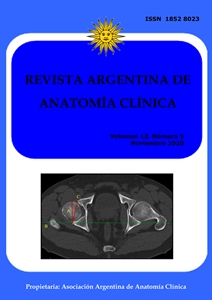Diferencias sexuales en la morfología de la cresta acetabular anterior
DOI:
https://doi.org/10.31051/1852.8023.v12.n3.29979Palabras clave:
diferencias de sexo, cresta acetabular anterior, curvaResumen
Objetivos: La morfología de la cresta acetabular anterior, una consideración importante en el diseño de prótesis de cadera, muestra una marcada variabilidad interétnica. Sin embargo, hay una escasez de datos locales que destacan la prevalencia de las diversas formas de la cresta acetabular anterior. Además, las diferencias relacionadas con el sexo apenas se han documentado. Por lo tanto, este estudio tuvo como objetivo determinar las formas de la cresta acetabular anterior en una muestra de población de Kenia y las diferencias de sexo en la misma. Métodos: se estudiaron noventa y cuatro huesos de cadera emparejados (44 mujeres, 50 hombres) de la colección de osteología de los Museos Nacionales de Kenia. Se determinó y registró la forma de la cresta acetabular anterior. Resultados: la cresta acetabular anterior fue curvada en el 34% de los casos, recta en el 24.5%, angular en el 21.3% e irregular el 20.2% de los casos. La curvada fue más frecuente en mujeres (50.0%) en comparación con los hombres (20.0%). Conclusión: el dimorfismo sexual influye en la morfología de la cresta acetabular anterior y debe tenerse en cuenta durante los procedimientos de reconstrucción acetabular y el diseño de prótesis acetabular.
Referencias
Aksu FT, Ceri NG, Arman C, Tetik S. 2006. Morphology and morphometry of the acetabulum. DEÜ Tip Fakültesi Dergisi 20:143-48.
Atkinson HD, Johal K S, Willis-Owen C, Zadow S, Oakeshott RD. 2010. Differences in hip morphology between the sexes in patients undergoing hip resurfacing. Journal of orthopaedic surgery and research, 5:76.
Delaunay S, Dussault RG, Kaplan PA, Alford BA. 1997. Radiographic measurements of dysplastic adult hips. Skeletal radiology 26:75-81.
Govsa F, Ozer MA, Ozgur Z. 2005. Morphologic features of the acetabulum. Archives of orthopaedic and trauma surgery 125:453-461.
Hur YM, Kaprio J, Iacono W, Boomsma D, McGue M, Silventoinen K, Martin N, Luciano M, Visscher P, Rose R, He M, Ando J, Ooki S, Nonaka K, Lin C, Lajunen H, Cornes B, Bartels M, van Beijsterveldt C, Cherny S, Mitchell K. 2008. Genetic influences on the difference in variability of height, weight and body mass index between Caucasian and East Asian adolescent twins. Int J Obes (London) 32:1455–1467.
Imber CE 2004. Robusticity and rugosity in the modern human skeleton. Doctoral dissertation, University of London.
Jordaan HV. 1976. The differential development of the hominid pelvis. South African medical journal 744-748.
Kigera JWM, Owira P, Saidi H. 2017. Scaphoid dimensions and appropriate screw sizes in a Kenyan population. East African Orthopaedic Journal 11:3-5.
Kopydlowski NJ, Tannenbaum EP, Smith MV, Sekiya JK. 2014. Characterization of human anterosuperior acetabular depression in correlation with labral tears. Orthopaedic journal of sports medicine 2:2325967114551328.
Krebs V, Incavo SJ, Shields WH. 2009. The anatomy of the acetabulum: what is normal? Clinical orthopaedics and related research 467:868-875.
Lavy CBD, Msamati BC, Igbigbi PS. 2003. Racial and gender variations in adult hip morphology. International orthopaedics 27:331-333.
Loder RT, Skopelja EN. 2011. The epidemiology and demographics of hip dysplasia. ISRN orthopedics
Maruyama M, Feinberg JR, Capello WN, D'Antonio JA. 2001. Morphologic features of the acetabulum and femur: anteversion angle and implant positioning. Clinical Orthopaedics and Related Research 393:52-65.
Msamati BC, Igbigbi PS, Lavy CBD. 2003. Geometric measurements of the acetabulum in adult Malawians: radiographic study. East African medical journal 80:546-549.
Murtha PE, Hafez MA, Jaramaz B, DiGioia Iii AM. 2008. Variations in acetabular anatomy with reference to total hip replacement. The Journal of bone and joint surgery. British volume 90:308-313.
Pollard CD, Sigward SM, Powers CM. 2007. Gender differences in hip joint kinematics and kinetics during side-step cutting maneuver. Clinical Journal of Sport Medicine 17:38-42.
The World Factbook. URL: https://www.cia.gov/library/publications/the-world-factbook/fields/2018.html (Accessed December 2018).
Ukoha UU, Umeasalugo KE, Okafor JI, Ndukwe GU, Nzeakor HC, Ekwunife DO. 2014. Morphology and morphometry of dry adult acetabula in Nigeria. Rev Arg de Anat Clin 6:150-155
Umer M, Thambyah A, Tan WTJ, De SD. 2006. Acetabular morphometry for determining hip dysplasia in the Singaporean population. Journal of Orthopaedic Surgery 14:27-31
Vandenbussche E, Saffarini M, Delogé N, Moctezuma JL, Nogler M. 2007. Hemispheric cups do not reproduce acetabular rim morphology. Acta orthopaedica 78:327-332.
Vandenbussche E, Saffarini M, Taillieu F, Mutschler C. 2008. The asymmetric profile of the acetabulum. Clin Orthop Relat Res 466:417-423.
Vyas K, Shroff B, Zanzrukiya K. 2013. An Osseous Study of Morphological Aspect of Acetabulum of Hip Bone. International Journal of Research in Medical Sciences 2:78-82.
Wang SC, Brede C, Lange D, Poster CS, Lange AW, Kohoyda-Inglis C, Sochor MR, Ipaktchi K, Rowe SA, Patel S, Garton HJ. 2004. Gender differences in hip anatomy: possible implications for injury tolerance in frontal collisions. Annu Proc Assoc Adv Automot Med 48:287-301.
Wolf JM, Cannada L, Van Heest AE, O’Connor MI, Ladd AL. 2015. Male and female differences in musculoskeletal disease. Journal of the American Academy of Orthopaedic Surgeons 23:339-347.
Zeng Y, Wang Y, Zhu Z, Tang T, Dai K, Qiu S. 2012. Differences in acetabular morphology related to side and sex in a Chinese population. Journal of anatomy 220:256-262.
Descargas
Publicado
Número
Sección
Licencia
Derechos de autor 2020 Fidel O. Gwala, Dr Jeremiah Munguti, Dr Kevin Ongeti, Dr Kirsteen Awori

Esta obra está bajo una licencia internacional Creative Commons Atribución-NoComercial 4.0.
Los autores/as conservarán sus derechos de autor y garantizarán a la revista el derecho de primera publicación de su obra, el cuál estará simultáneamente sujeto a la Licencia de reconocimiento de Creative Commons que permite a terceros compartir la obra siempre que se indique su autor y su primera publicación en esta revista. Su utilización estará restringida a fines no comerciales.
Una vez aceptado el manuscrito para publicación, los autores deberán firmar la cesión de los derechos de impresión a la Asociación Argentina de Anatomía Clínica, a fin de poder editar, publicar y dar la mayor difusión al texto de la contribución.



